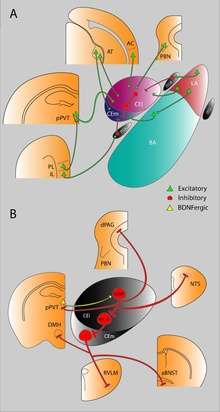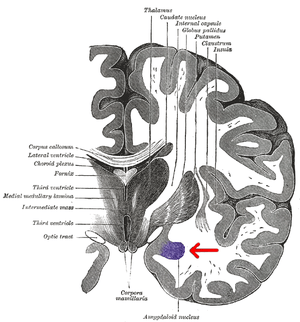Central nucleus of the amygdala
The central nucleus of the amygdala (CeA or aCeN) is a nucleus within the amygdala.[1][2] It "serves as the major output nucleus of the amygdala and participates in receiving and processing pain information."[3]
| Central nucleus of the amygdala | |
|---|---|
 | |
| Identifiers | |
| NeuroLex ID | birnlex_2682 |
| Anatomical terms of neuroanatomy | |
CeA "connects with brainstem areas that control the expression of innate behaviors and associated physiological responses."[4]
CeA is responsible for "autonomic components of emotions (e.g., changes in heart rate, blood pressure, and respiration) primarily through output pathways to the lateral hypothalamus and brain stem." The CeA is also responsible for "conscious perception of emotion primarily through the ventral amygdalofugal output pathway to the anterior cingulate cortex, orbitofrontal cortex, and prefrontal cortex."[5]
Amygdala subdividisions and outputs

The regions described as amygdala nuclei encompass several structures with distinct connectional and functional characteristics in humans and other animals.[6] Among these nuclei are the basolateral complex, the cortical nucleus, the medial nucleus, and the central nucleus. The basolateral complex can be further subdivided into the lateral, the basal, and the accessory basal nuclei.[7][8]

The amygdalofugal pathway (Latin for "fleeing from the amygdala" and commonly distinguished as the ventral amygdalofugal pathway) is one of the three principal pathways by which fibers leave the amygdala. The other main efferent pathways from the amygdala are the stria terminalis and anterior commissure. The anterior commissure also serves to connect the two amygdala.
The ventral amygdalofugal pathway carries output from the central and basolateral nuclei and delivers it to a number of targets; namely, the medial dorsal nucleus of the thalamus, the hypothalamus, the basal forebrain, the brain stem, septal nuclei and nucleus accumbens.
Research
- "psychological stressor induced an increase in both CRH mRNA levels and CRH content in the CEA. Exposure to the psychological stressor also caused a significant increase in CRH mRNA levels with a trend for an increase in CRH content in the dorsolateral subdivision of the bed nucleus of the stria terminalis (BNST) which is anatomically associated with the CEA."[9]
- "oxytocin in the CeA exerts a facilitatory role in the maintenance of hydroelectrolyte balance"[10]
- "the central nucleus of the amygdala (CeA) and its connections with the nigral dopamine system have been reported to modulate cognitive processes dependent substantially on attentional allocation. CeA dopamine function is involved in modulation of disengagement behavior."[11]
- "Opioid mechanisms are involved in the control of water and NaCl intake and opioid receptors (ORs) are present in the central nucleus of the amygdala (CeA)" μ-opioid receptors "in the CeA increases hypertonic sodium intake, whereas antagonizing these sites inhibits hypertonic sodium intake. …μ-ORs in the CeA in a positive regulation of sodium intake."[12]
- CeA "is essential for acquiring and expressing conditional fear after overtraining"[13]
- "glucocorticoids can facilitate CRH mRNA expression in the CEA, a site implicated in anxiety and fear"[14]
- Neuronal activity in the central nucleus of the amygdala was found to be a critical brain substrate for incubation of methamphetamine craving.[15]
References
- Keifer, Orion P.; Hurt, Robert C.; Ressler, Kerry J.; Marvar, Paul J. (1 September 2015). "The Physiology of Fear: Reconceptualizing the Role of the Central Amygdala in Fear Learning". Physiology. 30 (5): 389–401. doi:10.1152/physiol.00058.2014. PMC 4556826. PMID 26328883.
- Kalin, Ned H.; Shelton, Steven E.; Davidson, Richard J. (2004). "The Role of the Central Nucleus of the Amygdala in Mediating Fear and Anxiety in the Primate". Journal of Neuroscience. 24 (24): 5506–15. doi:10.1523/JNEUROSCI.0292-04.2004. PMC 6729317. PMID 15201323.
- Hasanein, Parisa; Mirazi, Naser; Javanmardi, Kazem (2008). "GABAA receptors in the central nucleus of amygdala (CeA) affect on pain modulation". Brain Research. 1241: 36–41. doi:10.1016/j.brainres.2008.09.041. PMID 18838064.
- LeDoux, Joseph E. (2008). "Amygdala". Scholarpedia. 3 (4): 2698. doi:10.4249/scholarpedia.2698.
- Wright, Anthony. "Limbic System: Amygdala". In Byrne, John H. (ed.). Homeostasis and Higher Brain Function. Neuroscience Online. University of Texas Health Science Center at Houston.
- Bzdok, Danilo; Laird, Angela R.; Zilles, Karl; Fox, Peter T.; Eickhoff, Simon B. (2012). "An investigation of the structural, connectional, and functional subspecialization in the human amygdala". Human Brain Mapping. 34 (12): 3247–66. doi:10.1002/hbm.22138. PMC 4801486. PMID 22806915.
- Best, Ben (August 28, 2012). "The Amygdala and the Emotions". The Anatomical Basis of Mind. Archived from the original on March 9, 2007.
- Solano-Castiella, Eugenia; Anwander, Alfred; Lohmann, Gabriele; Weiss, Marcel; Docherty, Carol; Geyer, Stefan; Reimer, Enrico; Friederici, Angela D.; Turner, Robert (2010). "Diffusion tensor imaging segments the human amygdala in vivo". NeuroImage. 49 (4): 2958–65. doi:10.1016/j.neuroimage.2009.11.027. hdl:11858/00-001M-0000-0010-ABE5-F. PMID 19931398.
- Makino, Shinya; Shibasaki, Tamotsu; Yamauchi, Naoko; Nishioka, Tatsuya; Mimoto, Tomoko; Wakabayashi, Ichiji; Gold, Philip W; Hashimoto, Kozo (1999). "Psychological stress increased corticotropin-releasing hormone mRNA and content in the central nucleus of the amygdala but not in the hypothalamic paraventricular nucleus in the rat". Brain Research. 850 (1–2): 136–43. doi:10.1016/S0006-8993(99)02114-9. PMID 10629757.
- Margatho, Lisandra Oliveira; Elias, Carol Fuzeti; Elias, Lucila Leico Kagohara; Antunes-Rodrigues, Jose (2013). "Oxytocin in the central amygdaloid nucleus modulates the neuroendocrine responses induced by hypertonic volume expansion in the rat". Journal of Neuroendocrinology. 25 (5): 466–77. doi:10.1111/jne.12021. PMID 23331859.
- Smith, Elizabeth S.; Geissler, Sydney A.; Schallert, Timothy; Lee, Hongjoo J. (2013). "The Role of Central Amygdala Dopamine in Disengagement Behavior". Behavioral Neuroscience. 127 (2): 164–74. doi:10.1037/a0031043. PMID 23316710.
- Yan, Junbao; Li, Jinrong; Yan, Jianqun; Sun, Huiling; Wang, Qian; Chen, Ke; Sun, Bo; Wei, Xiaojing; Song, Lin; Zhao, Xiaolin; Wei, Shuangyu; Han, Ling (2013). "Activation of μ-opioid receptors in the central nucleus of the amygdala induces hypertonic sodium intake". Neuroscience. 233: 28–43. doi:10.1016/j.neuroscience.2012.12.026. PMID 23270855.
- Zimmerman, Joshua M.; Rabinak, Christine A.; McLachlan, Ian G.; Maren, Stephen (2007). "The central nucleus of the amygdala is essential for acquiring and expressing conditional fear after overtraining". Learning & Memory. 14 (9): 634–44. doi:10.1101/lm.607207. PMC 1994080. PMID 17848503.
- Makino, Shinya; Gold, Phillip W.; Schulkin, Jay (1994). "Corticosterone effects on corticotropin-releasing hormone mRNA in the central nucleus of the amygdala and the parvocellular region of the paraventricular nucleus of the hypothalamus". Brain Research. 640 (1–2): 105–12. doi:10.1016/0006-8993(94)91862-7. PMID 8004437.
- Li, Xuan; Zeric, Tamara; Kambhampati, Sarita; Bossert, Jennifer M.; Shaham, Yavin (April 2015). "The Central Amygdala Nucleus is Critical for Incubation of Methamphetamine Craving". Neuropsychopharmacology. 40 (5): 1297–1306. doi:10.1038/npp.2014.320. ISSN 1740-634X. PMC 4367476. PMID 25475163.